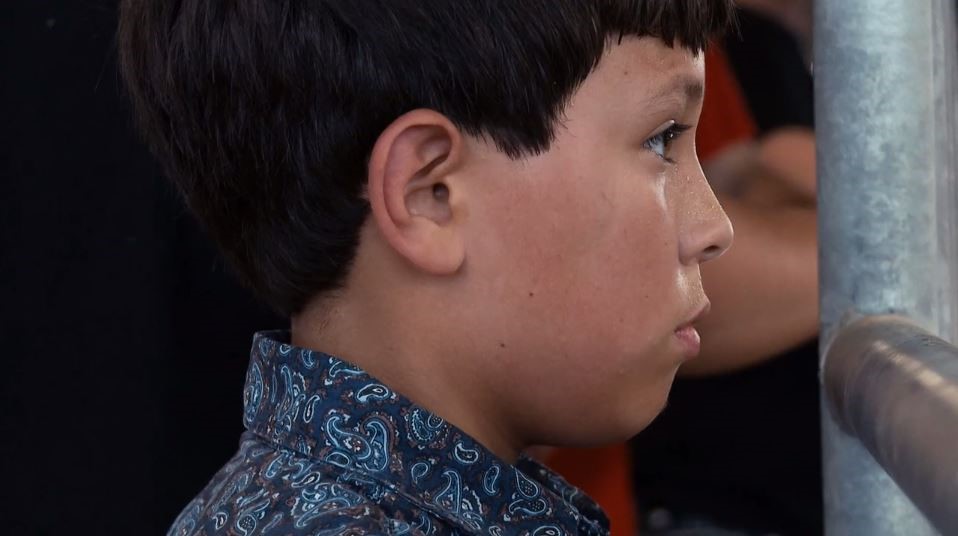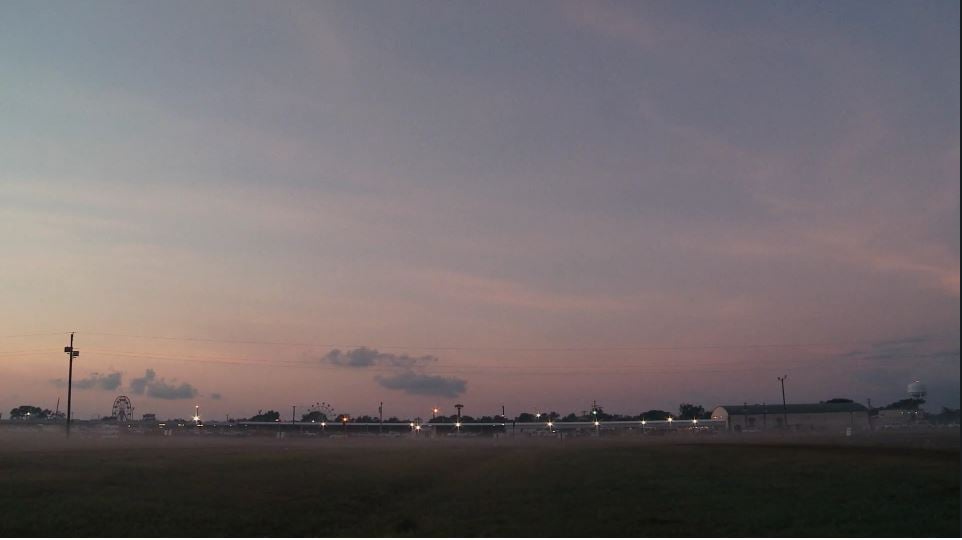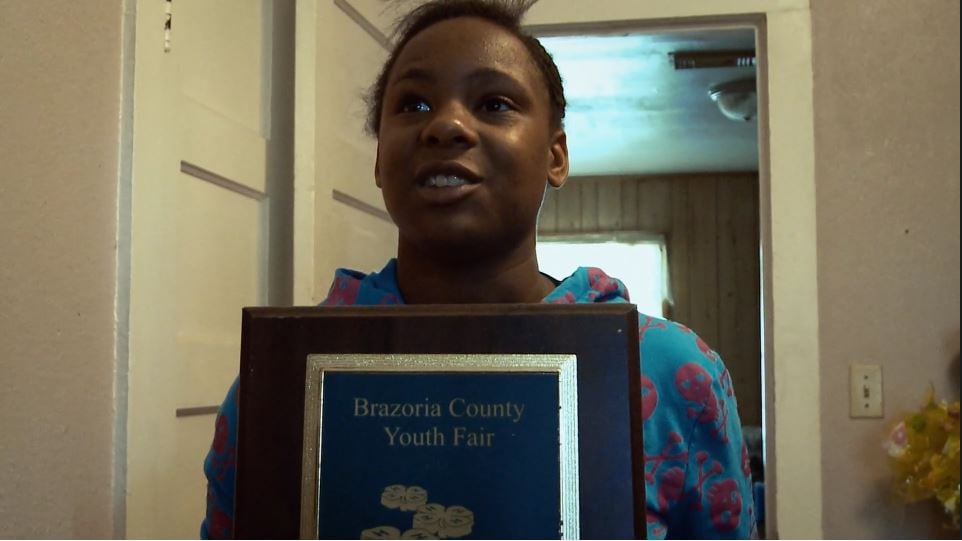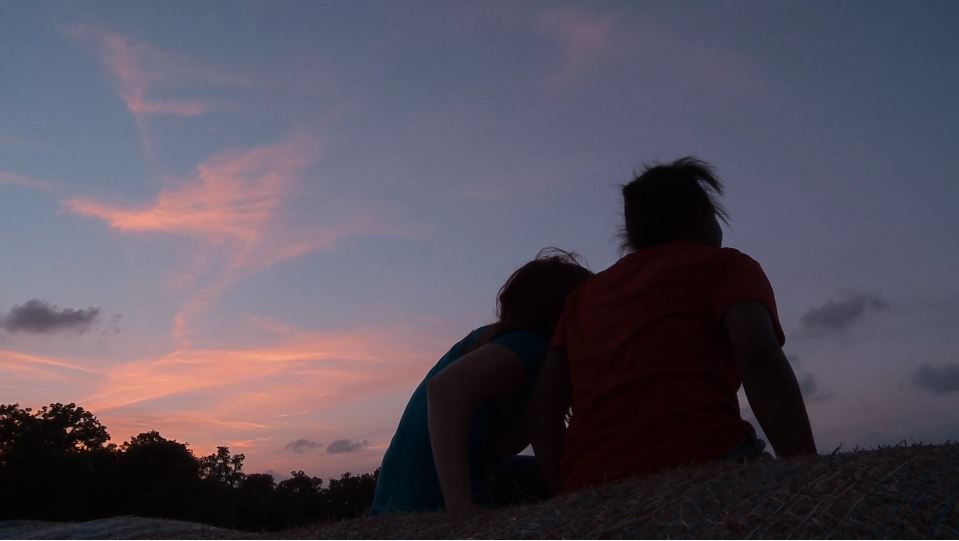Frame of Mind: County Fair, TX
ArtandSeek.net September 7, 2016 53“My’s [pig’s] name’s gonna be Bacon,” declares Tate, as he walks around the pig pen, knowingly appraising each piglet for its growth potential.
The young boy is about to embark on a yearlong ordeal leading up to the Brazoria county fair. He will spend untold, unglamorous hours feeding, washing, shaving, and training young Bacon to be the hog worthy of a blue ribbon. One tough year later, the time has come and Bacon must go dance for the judges in Brazoria. Tate taught him a stately walk, gave him a healthy shine, and together they marched into their coliseum, the Brazoria County Fair. But on that day, Tate and Bacon came up short. The judges were not impressed with Bacon’s performance.
“Embarrassed the (explitive) out of ourselves,” said Tate, as he walks away from Bacon and stares, forlorn, into the distance, thinking about all of the things he could have done different. Finished with them, he turns and steels himself for next year at the Brazoria County Fair.

Tate after the competition
These are the human moments and stories that permeate every minute of Brett Whitcomb and Bradford Thomason’s documentary, “County Fair, Texas”.
Whitcomb follows four kids from the day they choose their animals to judgement day at the Brazoria County Fair. Even viewers who have spent time in rural Texas will understand the essence of, “County Fair”. The film speaks in a language that transcends outer trappings; its narrative runs much deeper, down into the heart of youth and home. “County Fair” is an homage to home. It is a love letter to Texas.
Filmmaking partners Brett Whitcomb and Bradford Thomason were considering opportunities outside of Texas when they started making this documentary. The success of their two previous documentaries, “GLOW” and “Rockafire Explosion,” garnered them new creative prospects, and in the midst of thinking about what was next for them, Whitcomb and Thomason felt it was only fitting to make a documentary that embodied their memories and nostalgia for Texas.

Brett Whitcomb and Bradford Thomason
Both Whitcomb and Thomason grew up in towns within Brazoria county and lived in the culture that they portray in the documentary. A profound sense of reverence and love for this state and its people suffuses each frame and produces a sense of wonderment despite its seemingly commonplace subject matter.
I spoke with Brett about the film.
Where did you grow up?
I grew up in a small town called Alvin, TX. Home of Nolan Ryan and where we shot “County Fair.

Brazoria County Fair and the Texas sky
It seems like in your documentary, you have a great feel for the competitive animal raising culture. Were you ever involved in Future Farmers of America?
Yes, definitely. Brad and I did not participate [in FFA] Brad grew up in Pearland, TX which is just down the road from Alvin. Same kinda deal. FFA didn’t have quite the presence in his school, but it was very popular in [my] school in Alvin. I never really participated in it, but I was always very interested in what they were doing, and their blue jackets were very prominent, so it was always there…I never really got into that…but I did enjoy that country, open field, you-don’t-live-next-to-your-neighbor kind of deal. So I think that kind of stuck with me, and that imagery probably bled over into the look of the film.
The people in your film are very comfortable with you and your camera. How did that happen?
That’s something that we strive for. We spend time with people. We don’t just walk around thinking ‘what should we make a movie about?’ It has to be something that strongly resonates with us and something that we’re incredibly passionate about. We think about what moves us first and then we think about logistics. So we have the utmost respect for these people, and the fact that for any film we’ve ever done, people let us come in their home with cameras and sound and record them in their most intimate moments: eating breakfast, waking up, meeting their animal for the first time. It’s something we really appreciate and we try to respect that in every way.

Jonathan prepares to ride a live bull at rodeo school.
For Jonathan (one of the main characters) for example, I went to a bunch of his football games first and we hung out; I was at [his] school, I met his family a lot, and we talked a lot before we started filming.
There seems to be a theme in your documentaries; You find these niche cultures, and you communicate them beautifully. How do you take something that is almost entirely foreign to most people and make it meaningful for them?
I think it comes back to having tons of respect and being a fan of whatever it is we’re doing. We’re hooked and interested first…I think it comes down to me being a fan of documentaries and a certain kind of look and wanting to have that kind of energy that came from a lot of older documentaries that I like, like Wes Blank films, and films where it was like a camera and a sound guy and they went and spent time [with their subjects].

Jonathan and his animal warming up to one another
I’m a super fan of old HBO documentaries from the mid ’90s. They’re very much just a camera observing something and then the movie ends.
I always talk to the people in our films and treat them like family. I talk to them and explain to them that we’re not doing a reality show, that we’re really just observing and that whatever happens, happens and if we don’t have a film when this ends, it’s not the end of the world because the experience was worth it too.
“With “County Fair” we took a big chance in terms of ‘would it be interesting?’, ‘would people care?’ On the surface it seems pretty boring, and I think to some people it probably is boring if you’re not into observing this culture, but we always said maybe in 20 years it’ll age well and it’ll be a nice portrait of a time that is lost. I don’t know how long kids are going to raise farm animals in a school. It’s a little strange, and so it might be gone, and when it’s gone we think maybe this someone will find this movie in a garage sale or something and have a portrait of this time where kids raised animals in a high school.”

Tiffany showing one of her first awards
The attention to detail throughout the film makes it feel like you’re standing right next to the kids as they work toward their goals. How did you make the documentary so immersive?
A big conversation going into this was, ‘Who’s going to do the sound mix on this? Who’s gonna do the color?’ because we want this to be an immersive experience and when you’re watching Jonathan ride bulls, I wanted that to look scary, and sound scary, because it was. We used a guy named Lawrence Everson for the sound, and he’s the most fantastic sound mixer and sound designer that I’ve ever worked with…50 percent of what you’re feeling and hearing while watching this is due to his sound mix and his sound design.
I also noticed that there were a lot of beautiful sky shots that just hook the eye.

Tiffany and her friend enjoy the sunset
That’s what I remember from being a teenager…I’m sure the sky looks similar in everyone’s town, but to me that’s what a Texas sky looks like and I wanted to make sure to have those in the film to represent that, almost in a nostalgic way.

Tori, her father, and a family friend, shoot the breeze
There’s something very special about the randomness of doing a documentary like this that’s not controlled by anything. You’re following it, you’re very helpless, and all you can do is try to capture these beautiful moments in between.
What’s next for you?
“Well, it’s funny you ask that, because when we get off the phone, I’m submitting our new film to Sundance called “A Life in Waves.” It’s about the life and work of synthesizer and pioneer and composer Suzanne Ciani. We did a Kickstarter, and we just finished the film.
The interview with Tiffany where she talks about her biological mom is so raw…how did you get to that moment?
“Just spending time with her. It was almost like at that point we were just hanging out, and I had a camera like I always did. And instead of looking at her, I’m filming her. That’s what it feels like…I didn’t ask her [about her mom]…Tiffany would give glimpses of her life. I learned everything about her through filming. I didn’t want to know too much when we went into this. I just knew that I really liked her, and I really thought she was charismatic, and I thought she was super sweet and just genuine. She didn’t care about the camera at all. So she was a home run. So, things just came out here and there, and one night the sky was the most beautiful…

Tiffany and her friend at sunset, perched atop the hay bales
We were talking about her mom earlier in the day, and I said, “Do you mind if we just go sit in that field and talk about your mom?” and she said “Yeah, let’s go.” I actually didn’t know if I had a great shot; it was dark, and I didn’t know if it would be usable, but the sky was kind of pushing this along, saying, “Hurry up because you’re about to lose this.” I just sat down and said, ‘Tell me,” and she just started talking. She got up herself after she felt like she was done and walked off. It was a moment that I’m really proud that was captured because those are the reasons that I make films. Capturing real moments like that and getting them out to an audience to see that kind of stuff and then maybe they can relate to that in some way; that’s the magic of this kind of film. That kind of stuff is worth it. Even if we’re not going to make any money off it, it’s worth it that people get to see that.
This Q/A has been edited for brevity and clarity.










